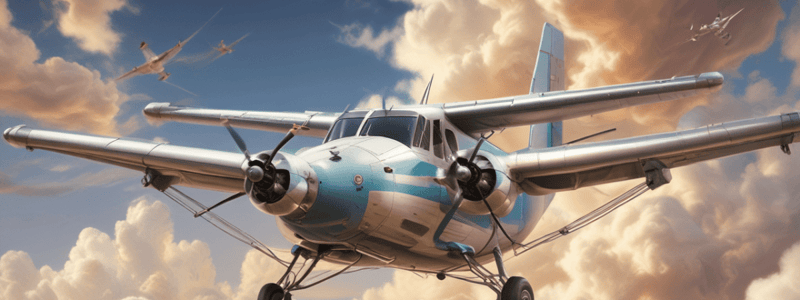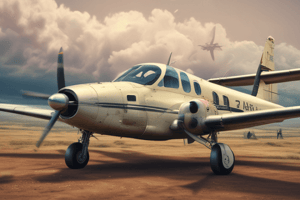Podcast
Questions and Answers
What primarily causes the leans illusion in pilots during flight?
What primarily causes the leans illusion in pilots during flight?
- Discrepancies between vestibular and motion signals (correct)
- Rapid changes in altitude
- Incorrect instrument readings
- A sudden movement of the aircraft
What is the primary strategy recommended for pilots to counteract spatial illusions like the leans?
What is the primary strategy recommended for pilots to counteract spatial illusions like the leans?
- Using flight instruments for confirmation (correct)
- Trusting their initial instinct about the aircraft's position
- Asking for confirmation from co-pilots
- Relying solely on visual cues outside the cockpit
What sensation might a pilot incorrectly feel after correcting a prolonged bank turn in a graveyard spiral?
What sensation might a pilot incorrectly feel after correcting a prolonged bank turn in a graveyard spiral?
- They are turning in the opposite direction (correct)
- They are completely level
- They are descending slowly
- They are climbing steeply
Which of the following statements about the graveyard spiral is true?
Which of the following statements about the graveyard spiral is true?
In the context of spatial illusions, what role does the vestibular system play?
In the context of spatial illusions, what role does the vestibular system play?
What can be a potential consequence of not correcting for spatial illusions during flight?
What can be a potential consequence of not correcting for spatial illusions during flight?
Which of the following best describes the leans illusion?
Which of the following best describes the leans illusion?
What might lead a pilot to unintentionally tighten their turn in a graveyard spiral?
What might lead a pilot to unintentionally tighten their turn in a graveyard spiral?
Why is trusting flight instruments critical when dealing with spatial illusions?
Why is trusting flight instruments critical when dealing with spatial illusions?
What happens to the fluid in the inner ear during a prolonged bank turn that contributes to the graveyard spiral illusion?
What happens to the fluid in the inner ear during a prolonged bank turn that contributes to the graveyard spiral illusion?
The leans illusion results from a discrepancy between the expected motion signals and the actual orientation of the aircraft.
The leans illusion results from a discrepancy between the expected motion signals and the actual orientation of the aircraft.
Pilots are trained to rely solely on their sensory perceptions to maintain proper aircraft attitude when experiencing spatial illusions.
Pilots are trained to rely solely on their sensory perceptions to maintain proper aircraft attitude when experiencing spatial illusions.
During the graveyard spiral, the pilot may mistakenly believe they have leveled off when, in fact, they are still in a turn.
During the graveyard spiral, the pilot may mistakenly believe they have leveled off when, in fact, they are still in a turn.
The vestibular system plays no significant role in how pilots perceive their aircraft's movement.
The vestibular system plays no significant role in how pilots perceive their aircraft's movement.
The graveyard spiral can lead to a loss of altitude and potentially a spiral dive if not corrected in time.
The graveyard spiral can lead to a loss of altitude and potentially a spiral dive if not corrected in time.
Engaging in a gradual turn while flying can cause the pilot to experience the leans, potentially misperceiving level flight.
Engaging in a gradual turn while flying can cause the pilot to experience the leans, potentially misperceiving level flight.
Once the pilot stops experiencing the sensation of turning, they have safely leveled out in monitoring their flight path.
Once the pilot stops experiencing the sensation of turning, they have safely leveled out in monitoring their flight path.
Correctly interpreting aircraft attitude is essential for avoiding hazardous situations during flight.
Correctly interpreting aircraft attitude is essential for avoiding hazardous situations during flight.
Trusting flight instruments is considered less reliable than the sensations felt by pilots during flight.
Trusting flight instruments is considered less reliable than the sensations felt by pilots during flight.
Pilots do not experience any physical effect on their vestibular system during prolonged turns.
Pilots do not experience any physical effect on their vestibular system during prolonged turns.
What perceptual error occurs when a pilot feels they are leaning after a gradual turn?
What perceptual error occurs when a pilot feels they are leaning after a gradual turn?
Explain how the sensation experienced during a graveyard spiral can mislead a pilot.
Explain how the sensation experienced during a graveyard spiral can mislead a pilot.
Why do pilots experience the leans when returning to level flight?
Why do pilots experience the leans when returning to level flight?
What is the primary risk associated with misinterpreted sensations during a graveyard spiral?
What is the primary risk associated with misinterpreted sensations during a graveyard spiral?
How should pilots respond to sensory discrepancies caused by spatial illusions?
How should pilots respond to sensory discrepancies caused by spatial illusions?
What happens to the fluid in a pilot's inner ear during prolonged turns?
What happens to the fluid in a pilot's inner ear during prolonged turns?
Discuss the role of the vestibular system in producing the leans illusion.
Discuss the role of the vestibular system in producing the leans illusion.
What key factor enhances a pilot's ability to counteract the graveyard spiral?
What key factor enhances a pilot's ability to counteract the graveyard spiral?
What perceptual change occurs in pilots during a prolonged bank turn?
What perceptual change occurs in pilots during a prolonged bank turn?
Why is it dangerous for pilots to rely on sensory perceptions alone during flight?
Why is it dangerous for pilots to rely on sensory perceptions alone during flight?
Flashcards are hidden until you start studying
Study Notes
Spatial Orientation and Vision Systems in Aviation
- Understanding spatial orientation is crucial for commercial pilots to enhance safety and performance.
- Vestibular illusions are false perceptions of movement and orientation stemming from visual cues, inner ear sensors, and kinesthetic feedback.
The Leans
- Occurs after a prolonged turn; pilots may perceive tilting upon leveling the aircraft.
- Rooted in the semicircular canals of the inner ear, which adapt to constant motion.
- Symptoms include a sense of tilt, conflicting sensations between the body and instruments, and an urge to trust instincts over instruments.
- Prevention involves rigorous instrument flight training and frequent cross-checking with instruments to reject false sensations.
Graveyard Spiral
- Arises during a prolonged coordinated bank turn; pilots may mistakenly sense a level flight after adapting to the vertical forces of the turn.
- Symptoms include gradual altitude loss and increasing airspeed while perceiving the aircraft as in a level turn.
- This illusion can lead to catastrophic consequences if not recognized and corrected in time.
- Prevention focuses on trusting instruments and utilizing effective cross-checking and scanning techniques for accurate flight orientation.
Physiological Basis of Illusions
- Vestibular system limitations can lead to confusion during complex three-dimensional maneuvers.
- Sensory conflicts arise from gravity and inertia, exacerbated in low-visibility conditions (e.g., haze, darkness) where visual references are absent.
Situations Inducing Illusions
- Visual reference challenges may occur during rapid acceleration, deceleration, or in featureless environments.
- Frequent training and awareness of sensations experienced during flight can mitigate risks associated with spatial illusions.
Safety Strategies
- Prioritize instrument readings over sensory perceptions when flying.
- Develop a disciplined instrument scan and regularly validate body sensations with cockpit instruments.
- Engage in simulator exercises to enhance the ability to recognize and correct illusions before they progress.
Conclusion
- Awareness, rigorous training, and trust in instruments are essential for preventing spatial illusions.
- Mastery of techniques to deal with 'the leans' and 'graveyard spiral' equips pilots for safer flight operations.
- Continual practice and study will fortify understanding and improve decision-making capabilities regarding spatial orientation in flight.
Spatial Orientation and Vision Systems in Aviation
- Understanding spatial orientation is crucial for commercial pilots to enhance safety and performance.
- Vestibular illusions are false perceptions of movement and orientation stemming from visual cues, inner ear sensors, and kinesthetic feedback.
The Leans
- Occurs after a prolonged turn; pilots may perceive tilting upon leveling the aircraft.
- Rooted in the semicircular canals of the inner ear, which adapt to constant motion.
- Symptoms include a sense of tilt, conflicting sensations between the body and instruments, and an urge to trust instincts over instruments.
- Prevention involves rigorous instrument flight training and frequent cross-checking with instruments to reject false sensations.
Graveyard Spiral
- Arises during a prolonged coordinated bank turn; pilots may mistakenly sense a level flight after adapting to the vertical forces of the turn.
- Symptoms include gradual altitude loss and increasing airspeed while perceiving the aircraft as in a level turn.
- This illusion can lead to catastrophic consequences if not recognized and corrected in time.
- Prevention focuses on trusting instruments and utilizing effective cross-checking and scanning techniques for accurate flight orientation.
Physiological Basis of Illusions
- Vestibular system limitations can lead to confusion during complex three-dimensional maneuvers.
- Sensory conflicts arise from gravity and inertia, exacerbated in low-visibility conditions (e.g., haze, darkness) where visual references are absent.
Situations Inducing Illusions
- Visual reference challenges may occur during rapid acceleration, deceleration, or in featureless environments.
- Frequent training and awareness of sensations experienced during flight can mitigate risks associated with spatial illusions.
Safety Strategies
- Prioritize instrument readings over sensory perceptions when flying.
- Develop a disciplined instrument scan and regularly validate body sensations with cockpit instruments.
- Engage in simulator exercises to enhance the ability to recognize and correct illusions before they progress.
Conclusion
- Awareness, rigorous training, and trust in instruments are essential for preventing spatial illusions.
- Mastery of techniques to deal with 'the leans' and 'graveyard spiral' equips pilots for safer flight operations.
- Continual practice and study will fortify understanding and improve decision-making capabilities regarding spatial orientation in flight.
Spatial Orientation and Vision Systems in Aviation
- Understanding spatial orientation is crucial for commercial pilots to enhance safety and performance.
- Vestibular illusions are false perceptions of movement and orientation stemming from visual cues, inner ear sensors, and kinesthetic feedback.
The Leans
- Occurs after a prolonged turn; pilots may perceive tilting upon leveling the aircraft.
- Rooted in the semicircular canals of the inner ear, which adapt to constant motion.
- Symptoms include a sense of tilt, conflicting sensations between the body and instruments, and an urge to trust instincts over instruments.
- Prevention involves rigorous instrument flight training and frequent cross-checking with instruments to reject false sensations.
Graveyard Spiral
- Arises during a prolonged coordinated bank turn; pilots may mistakenly sense a level flight after adapting to the vertical forces of the turn.
- Symptoms include gradual altitude loss and increasing airspeed while perceiving the aircraft as in a level turn.
- This illusion can lead to catastrophic consequences if not recognized and corrected in time.
- Prevention focuses on trusting instruments and utilizing effective cross-checking and scanning techniques for accurate flight orientation.
Physiological Basis of Illusions
- Vestibular system limitations can lead to confusion during complex three-dimensional maneuvers.
- Sensory conflicts arise from gravity and inertia, exacerbated in low-visibility conditions (e.g., haze, darkness) where visual references are absent.
Situations Inducing Illusions
- Visual reference challenges may occur during rapid acceleration, deceleration, or in featureless environments.
- Frequent training and awareness of sensations experienced during flight can mitigate risks associated with spatial illusions.
Safety Strategies
- Prioritize instrument readings over sensory perceptions when flying.
- Develop a disciplined instrument scan and regularly validate body sensations with cockpit instruments.
- Engage in simulator exercises to enhance the ability to recognize and correct illusions before they progress.
Conclusion
- Awareness, rigorous training, and trust in instruments are essential for preventing spatial illusions.
- Mastery of techniques to deal with 'the leans' and 'graveyard spiral' equips pilots for safer flight operations.
- Continual practice and study will fortify understanding and improve decision-making capabilities regarding spatial orientation in flight.
Studying That Suits You
Use AI to generate personalized quizzes and flashcards to suit your learning preferences.




